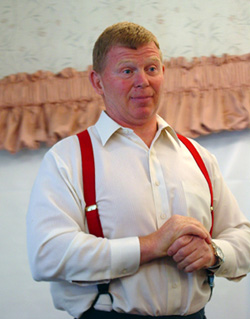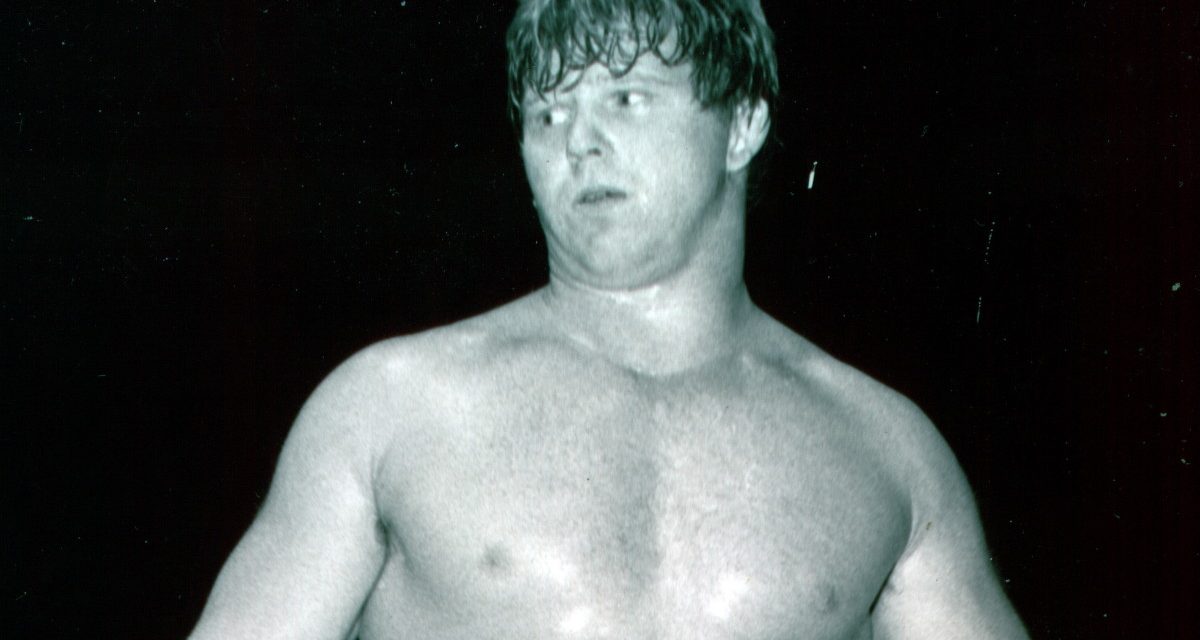PRINCETON, NJ – The alarm clock that sits beside Bob Backlund’s bed at his home in Glastonbury, Connecticut, is set to sound at 6:15 every morning. But it never gets a chance to awaken its owner.
A few minutes before the appointed hour, Backlund reaches out with his beefy hand, the same one that was raised in victory time after time before millions of wrestling fans, and flicks off the switch. He does not need an alarm to remind him that dawn has broken. He is ready to meet the day.
By his own admission, Backlund, now 50, would not have done that just a few years ago. The alarm would have sounded, his eyes would have been bleary, and he would have spent another day in the futile search of personal fulfillment.

Bob Backlund. Photo by Steven Johnson
For, by then nearly two decades removed from his six-year run as world champion, there were no crowds, no cheers, nothing to get the adrenaline pumping again. There was no motivation for the ultimate self-motivated man.
“I had been struggling. I couldn’t find a business that was rewarding enough to the point that I would be excited to get up in the morning,” Backlund said at a reunion of wrestling champions in New Jersey last weekend.
“In 2001, I got into the mortgage business. And that’s when I got excited about life again,” he said. “I start my day very positive because I’m alive. I think it’s very easy, once God gave you another day … you’ve got to be happy. There’s ups and downs in life, but always keep a smile. I think it’s healthy for you.”
Today, Backlund looks very much like he did in his prime as a star in amateur and professional wrestling. The crows’ feet around the eyes are more noticeable, but his grip is as powerful as a vise. He maintains an insatiable commitment to physical fitness and radiates the wide-eyed naiveté of someone whose harshest invective is “jeepers.” Put him in a white, picket-fenced house in Pleasantville, and he’d be a perfect fit.
It’s not an affectation. Backlund’s rise from an impoverished childhood in Minnesota to the top ranks of pro wrestling is a story befitting an “All-American boy,” which is the way he was portrayed – accurately – during his time in the ring. But his life also is the story of motivation lost and motivation found.
“I learned some things along the way,” he said. If something happens to you negative, you can’t blame it on other people. You’ve got to turn around and look at yourself first. And you’ve always got to find something positive out of the negative.”
Growing up in Princeton, MN, Backlund’s family lived on a farm with no outdoor plumbing, no electricity, and no television until he was about 16 – about 1970, long after such amenities had become run of the mill for most families. “We were poor,” Backlund said.
The farm boy started wrestling in eighth grade, and not necessarily on the mat. He said he got into more than his share of scrapes. He didn’t take learning seriously. Teachers did not like to see him come to school.
Only through his athletic ability was he able to slide through high school and to North Dakota State, where he played football and wrestled. He won the NCAA Division II wrestling championship at 190 pounds in 1971, and was inducted into the school’s Hall of Fame in 1983.
The motivation was on the field and on the mat, but even today, Backlund said his degree in physical education is “just a piece of paper” because he didn’t work hard enough to gain the knowledge to back it up.
“I confess I was lazy academically because I wasn’t motivated. You have to want to learn,” Backlund said. Before he dies, he wants to be able to read 5,000 words a minute. “In college, it was maybe 50 words a minute.”
Turning pro in 1973, Backlund headed to Baton Rouge, La., full of big ideas about money and championships. The money wasn’t there, and the room he booked for himself at a hotel went unused. He slept in the “voluminous” trunk of his car to save a few dollars.
But things moved quickly. He did well in Florida and St. Louis, two key National Wrestling Alliance territories, and was summoned to New York to meet Vincent J. McMahon, the father of the current WWE empire.
With no more than a handshake in 1978, Backlund embarked on a run that took him to the top of the federation. “Vince Sr. was a wonderful boss. We shook hands in 1978 and promised each other that our words meant something. And I’m proud of my word, too.”
Backlund drew well as WWWF champion against the likes of Ken Patera, Don Muraco, Pat Patterson, and even Harley Race, with whom he had NWA-WWWF title unification bouts. But Vincent K. McMahon gradually took over the business from his father with a very different view of the future of pro wrestling.
And goody-two-shoes Bob Backlund, who was regularly taking time to work with children’s groups, was not part of it.
The day after Christmas 1983, Backlund lost his title to the Iron Sheik, who promptly lost it to Hulk Hogan. McMahon wanted Backlund to dye his red hair and become a bad guy. For someone whose wrestling persona matched his real life persona, the idea of caricature was anathema to Backlund.
“That’s when I was into doing the stuff with the kids and I took it very seriously. That’s when I had to make a decision. I had a daughter who was six years old, too. I didn’t want to be doing certain things on television,” Backlund said.
“Having this relationship with Vince McMahon Jr. was a lot different than the father. We had differences. His dad liked a man who that would stand up for his word. [The younger McMahon] didn’t like a guy who would say no.”
Perhaps more surprisingly, Backlund said, in retrospect, that he was not as good a champion as he could have been.
“I don’t know if I was even a ‘good’ good guy,” Backlund admitted. “I don’t think I was, really. I don’t think I was as ‘over’ as I could have been.”
Part of that might have been his personality; Backlund acknowledged that he was something of a “loner” and a bit standoffish in the wrestling fraternity. “I was very sort of outside the business, almost. I’m not sure why, but when I look back, I wasn’t really ‘in’ like I should have been.”
Race, who has known Backlund from the outset of this career, attributed that to the fact that, as WWWF champion, Backlund was locked into the northeastern United States. He seldom wrestled in front of fans in other parts of the country, so there was no way he could gain their allegiances.
“This man was, at one point in time, as good as there’s ever been inside a wrestling ring. His problem was he was never allowed to venture out to other venues,” Race explained.
In 1993, Backlund, 43, took another stab at the WWF. He started with the same “Howdy Doody” image, but quickly shifted into a more memorable – and, he maintains, enjoyable – character.
“Mr. Bob Backlund” was a heel alarmed by the deterioration of standards and morals in and out of wrestling. He used ten dollar words and railed in indignation against the business. To “procure his signature” – Backlund-speak for an autograph – fans had to recite the names of the presidents in order.
The incredible thing is that persona was not far from Backlund, either. As he sees it, he didn’t change. Wrestling did.
“It was just as rewarding, being a bad guy,” he said. “I think it was one of the best experiences I’ve ever had in my life, being a bad guy. I learned more being a bad guy in two years, about life, about people, than I did my whole career trying to be a good guy.”
In November 1994, he beat Bret Hart in an “I Quit” match at Survivor Series to win the WWF world title. This time, he was the transitional champion, as he lost the belt in a matter of seconds three days later to Kevin “Diesel” Nash.
For a variety of reasons, WWF business immediately went into a slump. Backlund was not part of it. Judging by crowd reactions, he predicted to McMahon that fans would change his “Mr. Bob Backlund” character into a good guy.
“The bigger bad guy you are, the bigger babyface you’ll be. And I went to McMahon and said, ‘You know what? One of your worst nightmares is going to happen. I’m going to be your biggest babyface someday.’
“I was gone three days later.”
Backlund made sporadic appearances in the late 1990s as he sought a new direction for his life. In 2000, he ran for Congress as a Republican in Connecticut’s heavily Democratic First District, Backlund garnered 30 percent of the vote. He enjoyed the experience, which was a logical follow-up to a brief WWF “Backlund for President” angle.
“The reason I ran for Congress is I was looking for something. I didn’t win. I had a great time doing it. I had a theory that if you could get all the people that knew me in Hartford (Ct.), we’d win.” But too many people don’t vote, Backlund said. “I learned if we all voted, we’d control government, but it [voting participation] is under 50 percent.”
Backlund has made few wrestling-related appearances in recent years. There was some confusion about his presence in New Jersey last weekend as he interpreted his two-hour commitment to include speaking, meeting with fans, and signing autographs. In fact, the signings portion was to last two hours.
Promoter Terence Brennan said he wasn’t sure about the source of the problem, but that everyone who purchased tickets got to meet Backlund.
Still, Backlund is booked for a few more shows, and it’s a sure bet with the same message that has brought him to this station in life.
“If you have a negative attitude, bad things come into your world. It attracts more negativism. Positive mental attitude brings more happiness,” he said. “I’m not an expert speaker, but I enjoy telling my story.”
BOB BACKLUND STORIES
- July 23, 2016: Backlund & Iron Sheik headline Tragos/Thesz Hall of Fame
- July 19, 2016: Backlund says he ‘doesn’t deserve’ Tragos/Thesz Hall of Fame induction
- Feb. 3, 2016: Backlund’s book is not for everyone
- Aug. 29, 2004: World champs still reign supreme at fanfest

